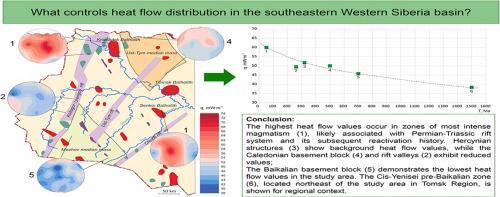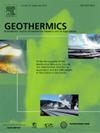西伯利亚盆地东南部热流分布的地质控制:来自热模拟的见解
IF 3.9
2区 工程技术
Q3 ENERGY & FUELS
引用次数: 0
摘要
虽然地热潜力通常在构造活跃地区进行评估,但稳定地区的沉积盆地也代表着重要的地热资源。准确评估沉积盆地的地热潜力需要了解热场的非均质性,这是本工作的中心研究问题。我们分析了西西伯利亚东南部沉积盆地的热流图,该热流图是由433个基于井的计算得出的。为了确定基底-沉积物界面的热流密度,我们通过一维热模拟程序Teplodialog应用Valery Isaev的方法。该方法建立在具有可移动上边界的水平层状固体热传导方程的数值解的基础上。利用克里格地统计学方法对所得数据进行插值,生成热流示意图。构建的地图(等高线间隔2 mW·m⁻²)通过其异常区与先前研究数据的强相关性证明了其可靠性。我们的研究结果表明,沉积盆地的热流分布与最后一次构造岩浆事件的年龄基本相关,这是控制热模式的主要因素。这种关系解释了观察到的热流与断层密度(在最近的构造岩浆活动区)和基底岩石组成(从构造演化史继承)之间的联系。岩石热性质的局部变化只能说明同时期构造单元内热流的微小差异。本文章由计算机程序翻译,如有差异,请以英文原文为准。

Geological controls on heat flow distribution in the southeastern Western Siberian Basin: Insights from thermal modeling
While geothermal potential is typically assessed in tectonically active regions, sedimentary basins in stable areas also represent significant geothermal resources. Accurate assessment of geothermal potential in sedimentary basins requires understanding thermal field heterogeneity – the central research problem addressed in this work. We analyze a heat flow map of the southeastern Western Siberia sedimentary basin, derived from 433 well-based calculations.
To determine the heat flow density at the basement-sediment interface, we applied Valery Isaev's methodology via the 1D thermal modelling program Teplodialog. This technique is founded on a numerical solution of the heat conduction equation for a horizontally layered solid body with a mobile upper boundary. The resulting data were interpolated using the Kriging geostatistical method to generate a schematic heat flow map. The constructed map (contour interval 2 mW·m⁻²) demonstrates reliability through a strong correlation of its anomalous zones with data from prior studies.
Our findings reveal that heat flow distribution in sedimentary basins fundamentally correlates with the age of the last tectonomagmatic event – the primary control governing thermal patterns. This relationship explains observed connections between heat flow and both fault density (positive correlation in zones of recent tectonomagmatic activity) and basement rock composition (inherited from tectonic evolution history). Local variations in rock thermal properties account for only minor heat flow differences within coeval tectonic units.
求助全文
通过发布文献求助,成功后即可免费获取论文全文。
去求助
来源期刊

Geothermics
工程技术-地球科学综合
CiteScore
7.70
自引率
15.40%
发文量
237
审稿时长
4.5 months
期刊介绍:
Geothermics is an international journal devoted to the research and development of geothermal energy. The International Board of Editors of Geothermics, which comprises specialists in the various aspects of geothermal resources, exploration and development, guarantees the balanced, comprehensive view of scientific and technological developments in this promising energy field.
It promulgates the state of the art and science of geothermal energy, its exploration and exploitation through a regular exchange of information from all parts of the world. The journal publishes articles dealing with the theory, exploration techniques and all aspects of the utilization of geothermal resources. Geothermics serves as the scientific house, or exchange medium, through which the growing community of geothermal specialists can provide and receive information.
 求助内容:
求助内容: 应助结果提醒方式:
应助结果提醒方式:


